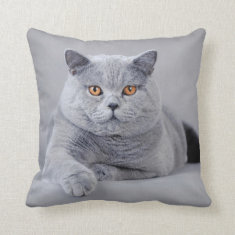History of the British Shorthair
The typical cats found in the British Isles hundreds of years ago were robust with a short, thick and water-repellent coat and a peaceful but confident personality. These cats quickly became highly valued not just for their hunting abilities and robustness, but also for their value as human companions. In the late 1800's the first attempts were made to breed this cat as a pedigree and by the 20th century British Shorthairs were firmly established in Britain and helping to establish the development of the American Shorthair in America.
Description of the British Shorthair Cat
The British shorthair is often described as a "cobby" cat - meaning the body is pleasantly sturdy and muscular - often with a squarish aspect. The legs are heavy boned and short with well rounded paws. The tail is short to medium in length and must end in a round or blunt tip. The coat is short, dense and very plush. This breeds head is one of its most endearing features - being massive but gently rounded with a broad skull. The ears are small and set widely apart to frame the very round and large eyes. The eye colour varies according to coat colour - Solid colour cats (Black, Blue, Chocolate, Lilac, Cinnamon, Fawn, Red, & Cream) have Copper/Orange eyes which may fade to a lighter colour as they age. Whites can have orange, blue or odd eyes (one of each). Tabby's will have either Orange or Green eyes. Colourpoints will have blue.
Size
British Shorthairs are medium to large, sturdy cats.
Males up to 17 pounds (8kg) Desexed males can grow even larger.
Females up to 12 pounds (6kg)
Coat
British Shorthair Cats are sometimes called the British Blue because that is the most commonly found colour but the shorthair comes in many colours and patterns. These include black, white, red, cream, lilac, chocolate, cinnamon fawn and may be in colourpoint, tabby and other patterns. The coat itself is dense and plush and only requires a weekly brush to remove loose hairs.
Temperament of British Shorthairs
This breed is well known for being easy going and reliable. As adults they are less active than many other breeds and will quite happily spend the time you are away snoozing on a comfy bed. They are not particularly vocal or demanding but are very affectionate and will quickly attach themselves to their humans. Their nature means they tend to get along with all other members of the household (whether furred or not) and will also tolerate living alone. They will readily communicate with humans by meowing or scratching at doors and generally enjoy following you around to see what you are doing. They don't generally enjoy being picked up but most prefer to keep all paws on the ground and for you to get to their level for a cuddle or smooch!
Health of the British Shorthair
This breed does not have any unusual health problems. They are considered a very robust breed but they can be prone to obesity given their solid build and laid back nature. They are one of the most prolific hair shedders of the cat world, and whilst the hair is short, they should probably be brushed 2-3 times a week to keep on top of it, or the owners will be forever vacuuming This will also help to minimise fur ingestion which can cause hairballs.
Possible Genetic Disorders of British Shorthair Cats
This breed was developed with a large gene pool which has helped to keep the breed healthy. Haemophilia B was found in a line of the breed in the 1970's but this has now mostly been eliminated by responsible breeding. Some lines of the breed can occasionally also be prone to heart disease and luxating patella. They may be prone to PKD (Polycystic Kidney Disease), but adults can be tested for this before being bred so choose a reputable breeder. They can also have HCM (Hypertrophic Cardiomyopathy), but as yet no research has identified the gene which causes this in British Shorthairs as they have in other breeds, and so usually isn't found in affected cats until they are close to dying, sometimes in old age.
Best Suited
- Quiet households - this cat does ok as a single pet.
- Busy and mixed households - they are very adaptable!
- Kept indoors. They are not a breed that is very fast because of their size & shape, so this is why they aren't suited to outside life. They will usually come off 2nd best to a car, dog, other cat, snake etc.
Not Suited
- For a back yard cat
- For owners who do not want to emotionally bond with their cat



